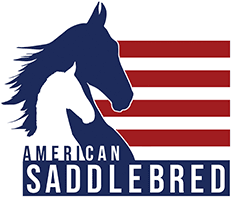
Continuing the Conversation - Getting a Mare in Foal
By Bob Funkhouser - Reprinted by permission from Saddle Horse Report - 4/18/2022
Since the UPHA Convention we have continued the conversation that was started by Jenny Taylor and Todd Graham from the ASHBA Breeding Committee. There has been concern regarding a pattern of falling numbers in the breeding of American Saddlebreds that has taken place over the past decade so Taylor, Graham, and a host of others created programs such as the Stallion Sweeps – which is being used in the American Saddlebred and Morgan industries – to bring awareness to the breeding industry and inspire others to become breeders.
Their goal is not only to inspire others but to help give them the knowledge to get into that side of the business while also helping those who already have broodmares. In the last article, several breeders spoke about what they were looking for when selecting a stallion for their mare. This time Melissa Moore and Todd Graham share their views on the different options a mare owner has in attempting to get their mare in foal. You wouldn’t think it would be that complicated but there are options and factors, when determining your path.
“Where does a newbie start?” asked Todd Graham. “There’s just not a lot of information readily available in our industry unless you have contacts or ask another breeder. We as a breed have dropped the ball on this.” Both Graham and Melissa
Moore agreed that once you’ve determined what stallion you’re going to breed your mare to there are a few other questions to be answered, namely your budget. “There is the least expensive, more expensive, and the most expensive
options,” said Melissa Moore. “If you’re inexperienced you need to ask a professional, probably your trainer if you’re thinking of breeding your show mare or acquiring a broodmare
Some of it will be determined by what is your intent for your mare. Do you want to breed her but continue to show her? Do you want her to take a year off and carry the baby herself? Geography is also a big factor in your decision making. What’s available to you?”
The hypothetical question Graham pro- posed is, “A family’s daughter has a show mare and the daughter is off to college so they decide it might be nice to raise a foal while the daughter is at school. What are their options? What vets do they use? Do they know live cover is available and would save money?”
In looking at their three levels of expense, live cover is the least expensive, yet the hardest option to find as not many people offer it. ASHBA does have a list of pasture breeding stallions. “I understand the fear of it but the per- centage of getting mares in foal is much higher. It is absolutely the best way, but limiting. Most stallion owners have limited space to offer this,” said Graham.
“I have a stallion that I pasture breed and do so with no problem, including with some of my good mares,” said Moore. “For someone sending a mare I make sure they have a clean culture. They usually spend about 45 days here and then they can go home. If you’ve tried shipped semen a couple of times and your mare hasn’t gotten in foal, then live cover is usually a more successful option.”
The middle level of expense is Artificial Insemination (A-I), either with fresh cooled or frozen semen. A-I has made it easier for the mare owner who doesn’t live in Kentucky or another heavily populated area with breeding stock. The saying goes, “Fed Ex delivers.”
According to Graham, and Moore agreed, “the stats on fresh cooled are a little better than frozen but in my experience, if you have a good vet and quality semen, either way is good.”
“Frozen semen is a little more expensive than fresh cooled as it usually requires two days in the clinic for the mare. You have to inseminate a little closer to ovulation and it takes a little more expertise.”
Then we have the most expensive level that is the use of embryo transfer or ocytes. This level is used for mares that can’t carry their own foal or if you have a great show mare or proven producer and want multiple foals in the same year. This basically involves the collecting of a fertilized oocyte (embryo) from a donor mare (your mare) and transferring it to the synchronized reproductive tract of a recipient mare. Besides the expense of the recipient mare, the more technology and vet work required, the more costly it becomes.
No matter the situation, options are good and when it comes to spending substantial money and involving a lot of emotions, options and information go a long way in making the percentages for a successful outcome in your favor. And that’s just to get that baby on the ground, breathing and nursing.
It’s only just begun!
